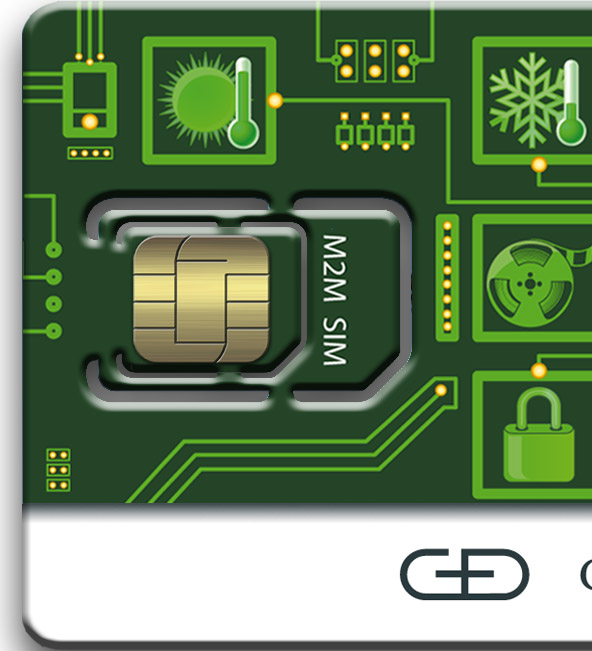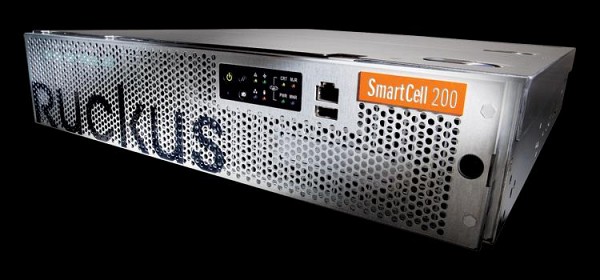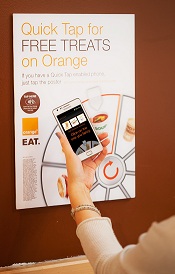Huawei backs small cells plus SON, but not femtocells
Huawei is stepping away from the femtocell business, as it is not convinced that there is a viable business case for the technology, according to Lars Bondelind, Vice President, Wireless Networks Marketing, Huawei.
“Femtocell is a market we didn’t see take off. It’s very difficult to build a business case with femtocells. We followed the market but we are not making any great efforts in the future to develop it. It’s been three to four years and operators are really using it as a coverage solution for people with a bad signal,” he said.
But that doesn’t mean Bondelind sees no future for small cells in the network. Far from it.
“The Huawei Atom cell is a 2W unit with active antenna, that can be deployed in modular format to increase power, and can be co-ordinated with the macro network to get the most out of available spectrum,” he said.
The Atom cell is available only in single mode, either UMTS or LTE, Bondelind said. “This is because we know that operators require the UMTS solution today. Then when they move to LTE later, they can deploy the LTE Atom cell.” The lack of Multi-RAN support in the Atom, of course, will mean two small cell rollouts, for operators who desire both UMTS and LTE small cell deployments.
A co-ordinated deployment of small cells could increase capacity derived from split spectrum by up to 90%, he said. Huawei calls its SON capability SingleSON, echoing its SingleRAN capability.
The Atom, along with the ARU (Adaptive Radio Unit), Huawei’s active antenna macro product, form part of Huawei’s GigaSite suite of solutions.
Today Huawei also launched SoftMobile and Cloud EPC
Huawei said SoftMobile can optimise network architecture, achieve dynamic resource sharing, and improve the user experience. Macro-macro and macro-micro coordination can decrease interference between sites, it said, while Macro-macro coordination can improve site throughput. Network capacity can be improved with macro-micro coordination, it added.
Also introduced was the concept of Cloud EPC, Huawei’s concept for the future evolution of packet core networks operating on three layers: infrastructure, virtualisation, and applications. The infrastructure level involves the modularisation, unification, and standardisation of underlying facilities to improve capabilities and performance; the virtualisation level supports multiple logical network elements to dynamically share the infrastructure layer’s network resources; the virtualisation layer utilises an open API (Application Programming Interface) for the application layer to facilitate mobile broadband service innovation, accelerates development cycles of third-party applications, and helps improve QoE.
Samsung scores European LTE network trials
Claims Tier One operator trial to go live in first half of 2012
Samsung Telecom will announce an LTE trial with a multi-national European operator in the first half of this year. It will be the equipment vendor’s first LTE deployment outside of its strong markets of the USA (Sprint), Japan (KDDi) and South Korea (SKT, KT).
IP Hong, vice president and head of global sales and marketing at Samsung’s Telecom Systems Business, said that one of the major Tier 1 European group operators is lining up a trial with the Korean vendor. Samsung will put is equipment through its paces in trial 800MHz, 1800MHz and 2,GHz spectrum, he said.
The company will be in “a couple of other trials” in Europe, Hong said. The momentum is reward for investments Samsung has made in its European operation, based in the UK, he added. Samsung’s LTE solution is called Smart LTE, it includes a macro solution and a small cell solution that will be commercially available later in the year. The company has a contract for intelligent small cells with KDDi, that is due to go live commerically in October, Hong said.
The company will also announce in later this year that it will start manufacturing GSM equipment, to give it full 2/3/4G single RAN capability. The company using a reference software design from one of the “incumbent vendors” Hong said, with Samsung’s hardware.
“We were the first to deliver commercial LTE, and we are the last to deliver GSM,” Hong said. The late deployment means that Samsung can implement the latest GSM features, Hong added.
Hong claimed that Samsung is the number 3 LTE vendor globally.
Telenor hails stickiness of mobile money services
Mobile financial services to reduce churn and raise ARPUs
Speaking in the Financial Services Keynote at Mobile World Congress today, Telenor’s Kristin Skogen Lund, EVP and head of digital services and Nordic, Telenor, said that mobile banking and payments in the developing world should be of particular interest to mobile operators.
Skogen Lund stated: “We believe there is a great future in mobile banking for mobile operators. It is one of the biggest opportunities we have as mobile operators, especially in emerging markets, because of things like speed, simplicity and cost.
“As a mobile operator, these services make your churn go down and your average revenue per user go up; the stickiness of these services is essential,” she enthused.
Skogen Lund pointed to Telenor’s EasyPaisa service in Pakistan, run in conjunction with Tameer Microfinance , which brings mobile banking and transactions to the unbanked in that country. “This service is growing incredibly fast,” she stated. “We are seeing double digit growth month on month, and last year we passed 30 million transactions.”
She added: “We feel very few banks are in a position to make this kind of service, and we feel that mobile operators are in a brilliant position to take advantage of this.”
Research carried out by Boston Consulting Group on behalf of Telenor last year estimated that in the developing world, more than 2.5 billion adults, approximately 72% of the population, are unbanked, meaning they have no access to traditional financial services like banks.
At the same time, nearly 2.5 billion people in these same emerging economies have mobile phones. This means that there could be up to two billion mobile phone users who are currently unbanked that could be served through mobile financial services, Skogen Lund remarked.
Overall in the five countries covered in the study, including Pakistan and Bangladesh, mobile financial services has the potential to reduce financial exclusion by 5% to 20% through to 2020, and increase GDP by up to 5%, Skogen Lund stated.
Cisco Delivers Next-Generation Hotspot Small Cell Solution
Cisco has introduced what it is claiming it the industry’s first carrier-grade, end-to-end Wi-Fi infrastructure to deliver Next-Generation Hotspots (NGH). The company also announced that it is working with several leading global service providers, including AT&T, BT, PCCW, Portugal Telecom, Shaw Communications, Smart and True, to deliver innovative mobile services with a new generation of intelligent “small cell” solutions utilising licensed and unlicensed radio technology.
Cisco, which is now embedding Wireless Broadband Alliance (WBA)-approved NGH technology within its service provider Wi-Fi portfolio, said it recently became the first to deploy NGH technology to enable cellular-like roaming for Wi-Fi networks. The WBA’s NGH initiative is based on the Hotspot 2.0 specification established by the Wi-Fi Alliance and is designed to provide mobile users with a seamless Wi-Fi experience.
Cisco has deployed over 12 million access points, the majority of which can now be upgraded to support NGH, giving the company the most experience delivering the widest range of Wi-Fi solutions, including in-flight Wi-Fi, retail hotspots, stadium and large venue coverage, and extensive data offload deployments.
Cisco’s new Small Cell Gateway, based on the industry-leading Cisco ASR 5000 Series Mobile Multimedia Core Router, will enable operators to manage subscriber and service information while integrating 2G/3G/4G LTE and femtocell (licensed) networks with Wi-Fi (unlicensed) networks, to deliver seamless experiences across multiple heterogeneous access networks.
“We are now entering the post-macrocell era, where small cells also will play a critical role in delivering the next-generation mobile Internet,” said John Chambers, Cisco chairman and CEO. “Existing mobile network infrastructures simply cannot sustain the growth we’re seeing on their own. Tomorrow’s mobile Internet must span multiple networks and deliver seamless and highly secure mobile experiences. This requires an architectural approach powered by a cloud-intelligent network of networks. Cisco and our service provider partners see tremendous opportunity as we together build out these networks and empower the mobile Internet generation.”
Cisco’s technology innovations, deployments and industry-first solutions in small cells are expected to help operators address capacity constraints from spectrum limitations; scale coverage effectively; deliver seamless experiences across heterogeneous access networks; save on capital and operational costs, and facilitate the continuing explosion in mobile traffic, devices and new services.
WAC announces mobile direct billing solution
Mobile alliance releases cross operator, cross platform API to enable in-application payments
The Wholesale Applications Community (WAC) has today announced the beta launch of its in-application billing Network API with 9 operators: AT&T, Deutsche Telekom, KT, LG U+, Telefonica Group, Telenor Group, Telekom Austria Group, SKT and SMART Communications at the annual Mobile World Congress (MWC) event in Barcelona, Spain. This solution is an operator billing service that enables customers to pay for digital goods via their operator bill.
WAC’s In App Billing Platform offers developers an way to monetise their applications across a range of platforms and technologies, using a cross operator, reliable billing service. The merchant requires just a single contract to enable operator billing for digital goods across many operators. The WAC developed application also offers near real-time reporting; a WAC developer can implement a pricing change and get almost instant feedback on the impact of the change across operators.
WAC said its In App Billing Platform supports the growing merchant demand for a cross-platform simplified, reliable operator billing solution and offers merchants a more flexible pricing model, with fewer transaction discrepancies when compared to other solutions. For consumers, the WAC In App Billing Platform offers a trusted and easy ‘one-click’ method to pay for digital goods.
Peters Suh, WAC CEO, commented, “Today’s announcement is an example of the great work being done by WAC. The nine operators’ integration with the WAC Billing API is an important milestone for collaboration across the industry and we look forward to building on this announcement with other operator and API launches throughout this year.”
John Donovan, Senior Executive Vice President, AT&T Technology and Network Operations and chairman of the WAC’s network API project, said, “We’re very happy to be working with WAC on the beta trial of this platform. We adamantly believe that our industry needs a cross-operator solution for authentication, billing and other APIs. This is an imperative to our industry which requires a focus on speed and execution to enable the benefits of the mobile Internet for more customers.”
WiFi comes of age at Mobile World Congress
But operators must be careful with the customer experience
By Heather McLean
Wi-Fi data offload from the mobile network has come of age, according to key businesses in the Wi-Fi space. BelAir, Stoke, Ruckus Wireless, Ericsson and Orange have all stated that Wi-Fi is now a key technology in the bid to reduce capacity challenges in mobile networks.
Steven Hartley, practice leader of Ovum’s telco strategy practice, said Orange CTO Thierry Bonhomme stated yesterday evening that deploying Wi-Fi was as important as rolling out LTE. Hartley commented: “Orange has made no secret of its fondness for Wi-Fi over the years, but combining this statement with the prevalence of Wi-Fi announcements at MWC 2012 is testimony to the fact that it is no longer Wi-Fi ‘or’ cellular, but Wi-Fi ‘and’ cellular that is key to operators handling future traffic demands.”
BelAir said the use of Wi-Fi for data offload reflects a genuine hetnet model, as operators finally step up and embrace small cell technology. Husnain Bajwa, vice president of product marketing at BelAir, told Mobile Europe, “Wi-Fi offload will be a substantial story this year. Data consumption by end users is ever-increasing, and the gigabit consumer is among us now, with the top 2% to 3% of mobile subscribers are using more than 5GB per month. The hunger for data never seems to abate and video looks like it will be a big driver.
“If a mobile operator deploys 35 to 40 of our access points in a hot zone, they can easily offload 60 terabytes of data a year. That means substantial savings for mobile operators as it is far cheaper to roll out Wi-Fi than 3G, and a significantly improved user experience; the user benefits on Wi-Fi, and so does everyone on the mobile network because that heavy traffic is moved over.”
Last week BelAir announced it has been acquired by Ericsson, which is using the purchase to offer an integrated carrier Wi-Fi offering into the heart of the Ericsson hetnet strategy, and also to offer carrier grade Wi-Fi as a standalone product.
Yesterday Ericsson announced the introduction of small cell products, including a pico radio base station with integrated Wi-Fi, the Pico RBS. Hans Vestberg, president and CEO of Ericsson, said this means it is now possible to easily add small cells to the network in the form of Ericsson’s new small RBS products, using both 3GPP-licensed spectrum and unlicensed spectrum such as Wi-Fi, transported over the same backhaul.
Meanwhile, Ruckus Wireless yesterday launched SmartCell, a new line of small cell products specifically designed for service providers that includes the SmartCell 8800, a multi-radio outdoor access node developed to integrate 3G, 4G, Wi-Fi and backhaul into a single, lightweight, small form factor; and the SmartCell 200, the first scalable small cell hetnet edge gateway capable of supporting hundreds of thousands of Ruckus or non-Ruckus access points and millions of clients, as well as providing standards-based 3GPP integration into existing and future mobile core infrastructures.
Dan McBride, vice president of marketing at Stoke, commented, “Wi-Fi is now no longer a pariah to mobile operators; it’s needed to make capacity. In 2012 operators will really move forward in their Wi-Fi data offload. This is the second wave of Wi-Fi. The first wave was drowned out by 3G, but then smartphones came along and 3G crapped out, so now everyone’s saying they need Wi-Fi again.”
However, McBride warned that operators should be careful in how they deal with maintaining the customer relationship with regard to Wi-Fi for data offload. He explained, “Mobile operators authenticate users on Wi-Fi, but then they set them adrift. Wi-Fi is fine as short term relief to capacity overload, but it does lead to distance between the operator and customer, and user churn increases.
“This dump to Wi-Fi is a tactical offload technique, driven normally by the operations team who are the ones with the congested network to deal with. We need to include the guys with a little longer range view of the customer as well; understanding the user experience is important.”
NFC offers Orange route out of dumb pipe
Not that there’s anything wrong with a dumb pipe…
Mobile operators can use near field communications (NFC) as a strategy to avoid being labelled a ‘dumb pipe’, according to Daniel Gurrola, vice president of strategy and business development , mobile consumer, at Orange.
A solid NFC strategy is steering Orange away from being seen by consumers as a utility, Gurrola said.
“This is about Orange working to be relevant in people’s lives. NFC plays right into our vision, which has two angles: becoming our customers’ ‘digital coach’; and enriching their communications needs, wherever, however, easily and securely. When it comes down to it, we want to continue to be seen as relevant, and saying we want to be seen as relevant in people’s lives is the opposite of saying we want to be a dumb pipe.
“We mustn’t demonise the dumb pipe though,” he added. “You can make very healthy returns being a dumb pipe. The point is, Orange has decided we don’t want to be a dumb pipe.”
Orange sees NFC as the direction communications is evolving towards, Gurrola continued. “It’s a really exciting area. We see NFC as the third revolution; the first was SMS, the second was mobile broadband, and the third is NFC.”
Gurrola likened the evolution of NFC to that of apps: “Today you can see how apps have changed your life, but three years ago I was debating with people as to how significant apps were really going to be. We are at the same point with NFC now; will it really change people’s lives? We believe it will. We want to be active in shaping this area, taking a leading role with standards, deployments, investments, and working with OEMs.”
Orange is continuing to push NFC in France, with commercial roll outs of the technology in Nice and now Strasbourg. A further nine cities are to follow soon.
Orange is also trialling NFC in Spain and Poland, and expects deployments this year in Spain, where it is working with bank Santander, incorporating a mobile wallet featuring for the first time both Visa and Mastercard.
Gurrola stated that Orange is currently in discussions with local operators in both countries, not to coordinate launches, but to agree the NFC standards to be used and also to define interoperable business processes.
“What we want is a way for customers to access services that will be distinct between service providers, but that those services are easy to use, so the customer gets the same experience operator to operator. In order for NFC to have an impact, it has to involve local operators; you need interoperability,” he said. “NFC is a hard thing to do.”







